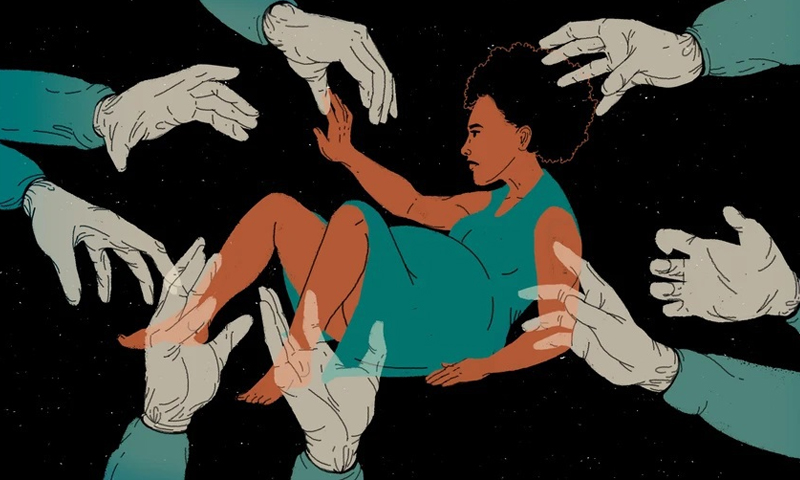Enab Baladi-Sakina Mahdi
“My dream was perfect. I made regular checkups. It was all normal until I was due, and went to the emergency department. There, the nurse yelled at me to follow her. In that hospital, I saw women screaming out of labor pain while nurses danced to high volume music,” Ranim al-Mashhadani, 26, described the day she gave birth to her baby at a Turkish hospital.
“I tried to pick up my cell phone. But the nurse burst in my face ordering me to follow her fast. I told her that I was in pain and could not just move that fast,” Ranim said, adding that the nurse insisted.
“She told me to take off my clothes and any metal objects I had on my body. I had gold bracelets on. They were stuck. The nurse told me to take them off even I had to fracture my rest. No one offered to help me, neither nurses nor the doctor. Also, no one was allowed to enter the room with me. I took off my clothes alone despite the excruciating pain. One of my legs cramped, but still none of the nurses helped me through the preparations.”
Childbirth is an exceptional experience, a complex one. Labor pain is also unique, and subjective. Women give different accounts of labor pain and draw various mental images of their feelings, affected by their subjective internalization of the experience and their mental status while in the delivery room. Accounts about pain also differ between first-timers and those who went through childbirth several times.
During labor, women become vulnerable and defenseless, unable to shield themselves against violence, abuse, or even humiliation which numerous women suffer from in various health facilities across the world. According to a report by the World Health Organization (WHO), “such treatment not only violates the rights of women to respectful care, but can also threaten their rights to life, health, bodily integrity, and freedom from discrimination.”
Enab Baladi conducted a survey on a closed Facebook group, membered by pregnant women. Women who had given birth in Turkish hospitals were asked to share their experiences. 685 women took to the comments section and narrated what they have been through. Of these women, 70 percent said that the experience was traumatizing, as they were subjected to violence in both private and state-run health facilities across Turkey. Only 30 percent praised staff’s treatment, adding that they were grateful.
Violence against a defenseless woman
Ranim said, “The nurse examined me. She said that I was ready for the procedure because she could see the baby’s head. However, the doctor in charge was so cold! She just walked away!”
The nurses forcefully tried to keep Ranim’s leg closed, obstructing birth till the doctor has finished what she was doing outside the delivery room. The nurses could not carry out the procedure without a doctor; they did not know how to do it.
“During labor, one nurse pressed my belly so hard that I stopped breathing for a few seconds. Another brutally shut my mouth and nose with the face mask. When the baby was already out, the doctor was doing the cleaning and had to stitch the wound. She showered me with insults, saying that she wanted to get done with this birth because I moved a lot and exhausted her.”
Dumbfounded to the day, Ranim added, “how could I make a move, with my both legs tied to the bed. She slapped me across my legs, yelling at me, asking me to stay still and stop moving. While I practically could not even budge.”
The WHO set up a guideline to usher medical staff through facility-based labor and birth, all designed to assist women into having a positive childbirth experience, summarizing a lengthy procedural code into three essential recommendations:
Respectful maternity care – which refers to care organized for and provided to all women in a manner that maintains their dignity, privacy and confidentiality, ensures freedom from harm and mistreatment, and enables informed choice and continuous support during labor and childbirth.
Effective communication between maternity care providers and women in labor, using simple and culturally acceptable methods.
A companion of choice is recommended for all women throughout labor and childbirth.
And to ease pain, the WHO recommends utilizing relaxation techniques, including progressive muscle relaxation, breathing, music, mindfulness and other techniques, are recommended for healthy pregnant women requesting pain relief during labour, depending on a woman’s preferences.
Screams of birth, suppressed!
Nour, 21, asked that her surname be withheld for personal considerations. Based in the Turkish city of Adana, Nour narrated the following, “the doctor asked me several questions in Turkish. I understood most of what she said but failed to answer her. I was so bewildered. She took me to the delivery room and left me there for four hours. It was extremely painful, but I did not scream because I have heard about the abusive treatment that women get when they scream out of pain.”
Nour felt sick and needed some bag to vomit in. The pain was overwhelming, and she could not force herself up, she had to scream. The answer was immediate, the nurse insulted her into silence, got some container, and threw it to her face
As her contractions increased, Nour added “the pain mounted. I could no longer tolerate it. I started wailing. But the staff just ignored me. I left the room with extreme difficulty to call on someone to help me. I felt like dying. One nurse yelled at me, hit me on my arm to get back into the room and wait. I screamed again, asking for my mother. My mother came in and called my husband. I could not take it anymore. I collapsed and wanted to leave the hospital immediately.”
The nurse asked Nour to sign a waiver, exempting the hospital from responsibility for any consequences or harm that might befall her once she left the facility. The nurse, however, did not care for the harm they caused her while still in their supposed care. The mother signed the document, and they left for another hospital. There, the birth was less painful and swift.
Nour said that the experience is etched on her memory; she hated pregnancy and childbirth. “I feel abused. It hurts deep inside. Even if I am given the chance to live 100 different lives; I still will never forget what I experienced through labor.”
In a 2015 article, Lamaze organization described birth noises as a mark of safety. “Most birthing moms use some kind of noise — or lots of noises — as a way to cope with contractions during labor and birth . . . [which] is actually helpful in relieving pain and progressing your labor.”
Abusive treatment and poor communication between women and staff during childbirth threaten women’s trust in doctors and facilities, to the extent that many would become hesitant to ask for help at certain critical moments during labor.
According to the website 28 May—International Day of Action for Women’s Health— violence during childbirth can be manifested through: the denial of treatment, the disregard of a woman’s needs and pain, verbal humiliations, invasive practices, physical violence, among others.” Nour was a victim of obstetric violence.
C-section can become wanton violence
Caesarean section, also known as C-section, or caesarean delivery, is the surgical procedure by which a baby is delivered through an incision in the mother’s abdomen. Doctors perform a c-section when vaginal delivery poses a potential threat to the lives of the mother of her baby. Other reasons for this include obstructed labor, twin pregnancy, high blood pressure in the mother, breech birth, and problems with the placenta or umbilical cord.
C-section is common practice across the world, and it offers a life-saving solution in sensitive childbirth situations. However, the WHO says that “many caesarean sections are undertaken unnecessarily however, which can put the lives and well-being of women and their babies at risk – both in the short and the long-term.” C-sections might cause adverse complications, a permanent disability, or death.
In a 2015 statement, WHO concluded that “at population level, caesarean section rates higher than 10% were not associated with reductions in rates of maternal and newborn mortality.” On the contrary, the procedure might put both mother and child’s life on the line when performed in non-specialized and unsafe facilities.
Sutures without anesthesia
Aylul Gulou, a Syrian woman who gave birth in a hospital in Istanbul, told Enab Baladi that “when I was due, they put me in the intensive care unit. I was left there alone for three days. The signs were clear it was labor. I started screaming out of pain, but the doctor threatened to tie me to a chair. The pain caused me to pass out repeatedly.”
The doctor decided she will go with a c-section. “They took me to the operations room. They grabbed my hands and legs and made an incision without anesthesia. They brutally pressed my abdomen. The operation ended, but not the nightmare. They stitched the wound also without numbing me. The thing that hurt me the most was that the nurses were giggling the whole time.”
Investigating into the common procedure and how often do doctors stitch a c-section’s wound without anesthesia, Enab Baladi interviewed the Libyan Istanbul-based gynecologist Awatif al-Muhammad. The doctor said that it is impossible to close the birth wound without applying local anesthesia.
The doctor emphasized that the code is to have the mother locally sedated, adding that the influence of sedation varies from a patient to another and that it lessens the pain, but does not eliminate it entirely.
Al-Muhammad added that beating women in childbirth is an extreme measure that doctors use with the intention of wakening up mothers who lose consciousness during the operation. Some women faint when the baby’s head pops out, and in this case a mother must be restored to consciousness no matter what, or the baby might be at the risk of choking to death. Doctors are permitted to slap the mother on the face under such circumstances.
The gynecologist, who also works for an Istanbul hospital, said that beating and violence during childbirth are unfamiliar, adding that she did not hear of such stories during her ten-year career.
She dismissed the stories as merely an attempt to distort the image of doctors in a society where patients tend to weave jaw-dropping tales, that are often used to criminalize doctors without evidence.
Denied justice for lacking evidence
Celine Muhammad, 22 from Syria, works as a translator in several Turkish hospitals in Istanbul and has witnessed many cases of violence against women during childbirth.
Muhammad told Enab Baladi that she reached out to Turkish journalists to shed light on these incidents, but they asked her for proof to be able to address the issue.
Once, Muhammad told Enab Baldi, “I was present when a woman with a narrow pelvis was giving birth. She had a difficult time. The nurses violently stripped her off her clothes, while she screamed out of pain. The doctor, male, started beating, humiliating, and insulting her. I was doing the translation. The woman asked me for help, but I could not do anything.”
Muhammad ran out of the delivery room to the nearest police station. She returned to the hospital with police officers, who could not do anything, as well. They asked the woman for proof of the accident, but she displayed no marks of beating, and there were definitely no pictures of the assault. The officers just left.
She added that the law does not recognize women’s complaints about violence, verbal or physical abuse, unless they present authorities with overwhelming evidence, sufficient to convict the involved doctor or nurse. Unfortunately, some forms of violence during childbirth do not leave marks on the body.
Muhammad added that obstetric violence is not exclusively racial or discriminatory, as she has witnessed cases of violence against Turkish women in delivery rooms.
According to May 28, “obstetric violence is an often overlooked type of Violence Against Women. Lack of information about the issue complicates the design of public policies to prevent and eradicate it. However, emerging evidence worldwide shows that women in childbirth are being subjected to varied degrees of ill-treatment – from subtle disrespect to their autonomy, to outright abuse.”
Obstetric violence under Turkish laws
Lawyer Bassam Fawal, an expert in Turkish Law, told Enab Baladi that victims of obstetric violence can demand justice by submitting an urgent request to the Department of Public Prosecution, demanding access to the hospital’s camera recordings, or through providing an eyewitness account.
It might be difficult to obtain eyewitness accounts because the internal regulations of some hospitals prohibit the admission of anyone with women to the delivery room, even though there are no texts in the Turkish law that mandate this procedure.
The lawyer added that affected people can prove violence by filming the victim as she leaves the delivery room to document beating marks, if any.
He stressed that authorities take into account recurrent complaints against a hospital or a doctor, even with no evidence.
Victims can unite into a pressure group and file a collective complaint against a particular hospital, by submitting any document proving that the woman gave birth in the facility in question, such as a payment receipt.
A convicted doctor or nurse is sentenced to prison for a maximum of three years and is banned from practicing medicine.
However, in some cases of violence, such as stitching the wound without anesthesia, doctors can escape charges by presenting a medical report claiming that anesthesia could have harmed the mother due to immunodeficiency.
According to recent official data, 3 million and 613,651 Syrians are registered with the Turkish Ministry of Immigration.
The latest figures by the Turkish Mülteciler Derneğialso (Refugees Organization) indicate that the number of Syrian children born in Turkey is increasing day by day. Between 2011 and 2019, the number of Syrian births in Turkey was estimated at about 450,000.
if you think the article contain wrong information or you have additional details Send Correction
النسخة العربية من المقال
-
Follow us :
Most viewed
- Printing Syrian currency in Europe... A file on the table
- Books make a comeback in Damascus libraries after being banned under Assad
- Complex steps to establish new Syrian army
- National Security Council in Syria: A necessity imposed by reality
- SDF-Damascus agreement in Aleppo: A test balloon for broader consensus












 Illustration by Julia Kuo (Vice)
Illustration by Julia Kuo (Vice)





 A
A
A
A
A
A








 More In-Depth
More In-Depth